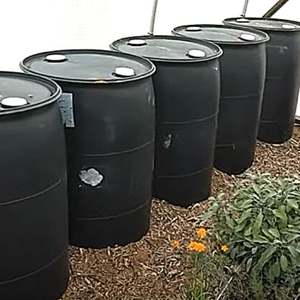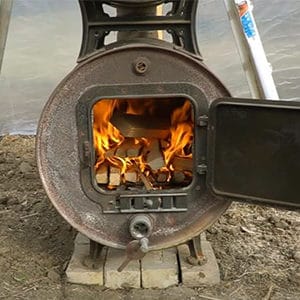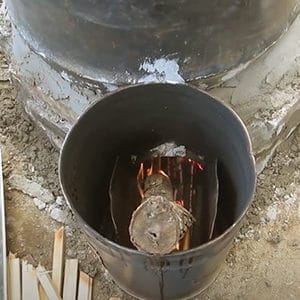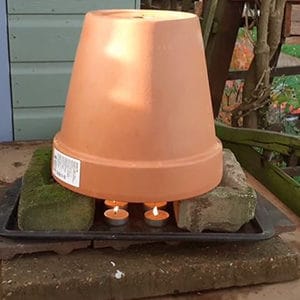Sometimes it’s really important to rekindle your old hobbies. But if your hobby is all about gardening, things can get a little sluggish, especially over the winter.
Every plant needs perfect weather, temperature, and environment to continue its growth without any disturbance. To grow some expensive plants, you must have to have a greenhouse and, of course, keep it hot.
It can take you a little to no expense to keep a hobby greenhouse warm if not a dynamic or large greenhouse in winter. However, it’s important to keep that house warm; otherwise, it might cause severe damages to your plants. So you’ve to take some steps to warm up the hothouse and monitor its temperatures.
Do you think that you’re able to keep your plant house hot enough on the colder nights? Confirm it by checking the temperature through a good thermometer. If your thermometer result is saddening, don’t worry; there are tons of things to solve this issue.
How Can I Heat My Greenhouse for Free?
The term ‘FREE’ doesn’t have any existence in the world nowadays. But you can arrange a few heating systems at a very low cost and use them without spending a penny hereafter.
Thermal Mass or Heat Sink
There are some available materials in nature that you can benefit from. This technique comes completely for free.
Thermal mass, also known as a heat sink, is any materials that store thermal energy in them. Water is the best material to keep the most heat amongst them all.
This can hold about 2 times more heat than concrete and 4 times more than soil. So surely, we’ll think of the first one, I mean ‘water,’ right?
These materials help you by absorbing heat during the day, not letting the environment get overheated.
Secondly, these will release the heat at the darker hours, increasing a few more degrees to the environment. You should apply this technique to keep your greenhouse warm that surprisingly comes absolutely for free.
Store water in 55 gallons of water barrels at the north side of the greenhouse. Northside receives the most sunlight, which will help the water to absorb the most heat.
As plants near the barrels will receive heat the most, keep the tender plants near them. Warm-season crops will grow happily around the water drums. Painting the drums black can maximize heat absorption.
You might even consider an aquaponics system to grow your favorite fishes and plants at the same time. This will benefit you in many ways.
Building concrete walls is another way to heat the greenhouse for free. Make sure to build the wall on the north side of the greenhouse where the concretes can get enough sunlight.
Composting
This is a favorite method to heat the greenhouse to wise gardeners.
It breaks down organic waste into the soil, making it more fertile while producing heat in the process. So yes, you get why it’s so popular.
Compost will make the soil nutrient-rich for plants that’ll grow in spring while heating the greenhouse in winter.
Be sure to keep the organic composting materials in the center of the greenhouse as compost will radiate heat outward to the greenhouse.
This will allow the produced heat to cover the greenhouse as much as possible. One negative side of this method is that it can smell bad and attract mice. So you better not apply this method in your indoor greenhouse.
Wood Burning Stove
A very cost-effective method to keep your greenhouse above freezing temperature. You can build that on your own.
You would need to collect a chimney. Brick chimneys should be good for you as it isn’t that expensive. But this won’t be effective in larger greenhouses. Also, you can’t grow tropical fruits with such heating methods.
You don’t have to run it the whole night. Burn it in the evening, and it will keep the greenhouse warm throughout the entire night.
When the days are colder with overcast weather conditions, you may run it in the morning to keep the house warm during the day.
Insulate It
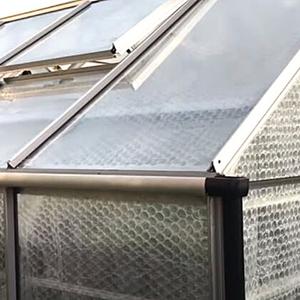
If not insulated properly, you can’t heat a greenhouse or keep it warm no matter how expensive you try.
Also, it makes a big difference when you line the inner of the greenhouse with horticulture material. It’ll prevent the heat from escaping.
It makes sense to block drafts before you start the insulation process. If there are any broken panes or seal gaps, replace them right away.
It’s even essential for you to check the doors and vents; they should fit securely. Otherwise, the heat should fly away in no time.
Now buy purpose-made horticultural bubble wraps that come with bigger bubbles as required. Because the bubbles are bigger, it’ll be easy to let the sunlight cross it easier to reach inside the greenhouse.
If your greenhouse is an aluminum one, attach the bubble wrap to the frame with greenhouse clips. But if your greenhouse is made with a wooden frame, you’ve to connect the bubble wrap using a staple gun or drawing pins.
You can lay bubble wraps on your tender plants for additional protection. Also, you should save polystyrene boxes for winter to insulate your trays of seedlings with them.
Make the Best Use of the Sun
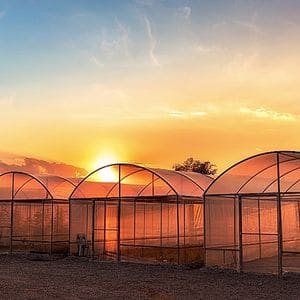
Sunlight can easily enter a greenhouse through the glass walls, and the heat is trapped inside the house. Almost everyone knows this mechanism.
We see the sun alone can’t warm the greenhouse alone in winter. But if you’re growing vegetables and winter is still a few days away, then the sun alone is enough.
In winter, you can make the best use of the sun by removing any obstacles coming between the greenhouse and the sun. It can be a shade of a big tree or your kid’s playthings.
The more sunlight enters the house; the more heat is produced. Remember to open the doors and vents on sunny days, which will let the sun do the job even better.
Heat Exchanger
There are different types of heat exchangers available on the market nowadays. They transfer energy and store it to use the energy when the temperature drops down.
In the daytime, the greenhouse gets overheated; then, a fan starts to pump warm air and send it underground through a network of pipes. Mostly a couple of layers of tubes are used in this system which is buried about 4 feet and 2 feet below the ground.
As soon as the temperature drops, the water vapor starts to condense. This process releases energy that is then stored in the soil, and this makes the soil heat up.
Then, when the temperature drops down at night, that fan starts again to extract stored heat from the soil. This way, the system helps to keep your greenhouse warm. It’s a very reliable method that people are using to keep their homes warm for decades.
Use Rocket Mass Heater
We already talked about the wood-burning stove to heat a greenhouse. Now it’s time to know about a better version of a wood-burning stove that is the rocket mass heater.
Why it is inexpensive is because you don’t need electricity in the greenhouse to run this. Instead, these heaters are run with fuel that’s cheap and renewable, making them very budget-friendly.
This can help you save up to 80% lesser wood than traditional wood-burning stoves. But, you must be thinking how!
This is possible because this type of stove firstly heats a mass of brick, cob, or stone by circulating hot air while the furnace is burning. As soon as the stove stops burning, the mass starts to release heat.
You’d need a natural material to work as a mass, such as brick, cob, or stone, and a cylinder or metal barrel to create a rocket mass heater. These kinds of heaters heat the mass and then heat the greenhouse.
So, the group will produce heat throughout the greenhouse once it has stopped burning. These heaters are designed with a double combustion chamber to heat the greenhouse the whole night when burnt just a few hours with a few pieces of wood.
Compost Pile Heater
A very effective heating system for larger greenhouses. Compost generates heat while breaking down the organic waste.
Along with compost, you’d need a heat exchanger like the underground heat exchanger. There’s a large tube grounded under the compost pile, which heats the water inside the tube.
The water is then circulated throughout the greenhouse and dispenses the heat. Most compost piles can create a high temperature which is between 100 to 160 degrees Fahrenheit.
Though this is quite time-consuming and takes a lot of effort to make a compost pile with the right materials than installing an underground heat exchanger, it’s the best solution to keep your big greenhouse warm in the winter.
Hotbeds with Composting Materials
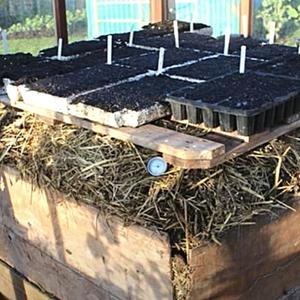
But make sure you’re using green and brown organic materials as the green materials contain a good amount of nitrogen while the other carries a hefty amount of carbon.
After mixing these ingredients and putting them in place, you have to top them with a light layer of soil and compost mixture. Finally, it’s time to germinate the seeds; make sure you’re putting the seeds in. For extra protection, you should cover the hotbeds with cloches.
Ground Heating
This is a very reliable method to make the best use of the sun. Fan pumps hot air to the ground through pipes, and the soil stores the heat as energy.
When the day ends and the temperature falls, the fan again extracts the heat from the ground and makes the greenhouse hot.
It would help if you had a good fan manufactured for this purpose and a thermostat to keep a record of the temperature. If the temperature rises too high, make sure to reduce the fan speed.
Rustic Heater Using Candles
This might sound funny to you at first, but trust me, even the heat that comes from a candle can act as a heater.
This is effective if your greenhouse isn’t a giant one. Besides a few candles, you need a plant pot as well. You should place a plant pot upside down and lighten up a few candles right below it.
Use a few strong and long metal sticks to hold the pot slightly higher than the candle’s height; otherwise, the fire will get extinguished.
This is a very cost-effective and innovative way to keep your greenhouse hot over the winter. Make sure to give it a try.
Final Thoughts
I know you must be confused about which heating system to use in your greenhouse this winter. Trust me; no one can choose it better than you because you know the size of your greenhouse and what you’re going to grow in it.
Some methods will keep the temperature just above the freezing temperature, while the others will keep it hot enough to grow your desired summer day veggies or tropical fruits.
So, decide to use the methods as per your needs, and you can even use two or more ways simultaneously.
